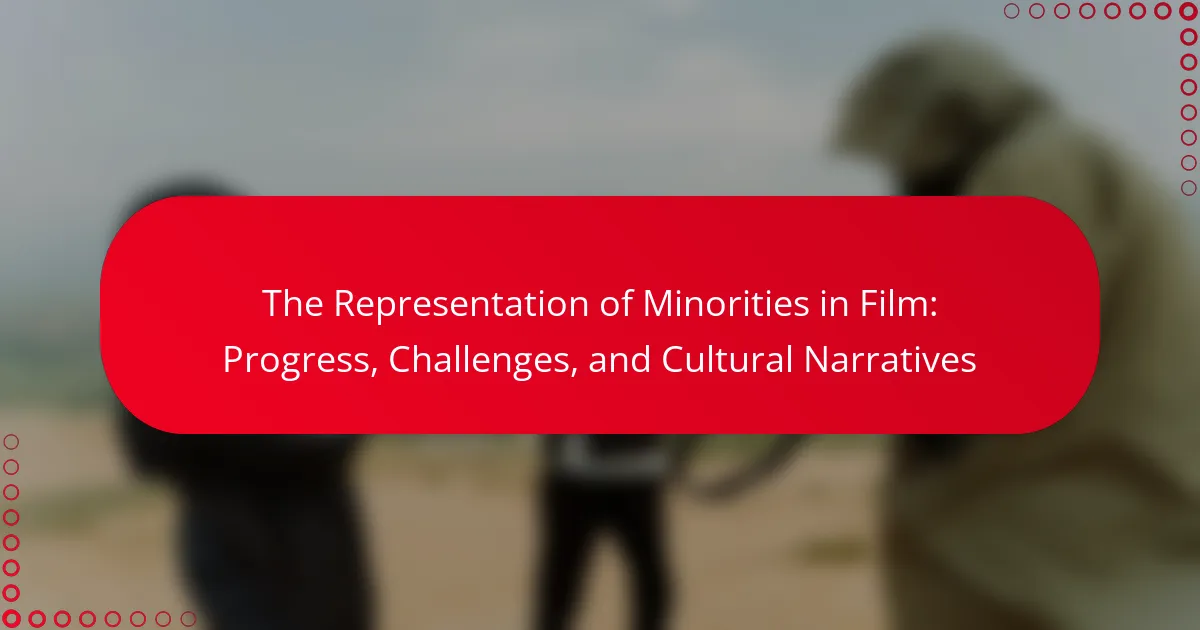The representation of minorities in film encompasses how individuals from diverse racial, ethnic, and cultural backgrounds are depicted in movies. This article examines the historical underrepresentation and misrepresentation of minorities in mainstream cinema, highlighting ongoing challenges such as stereotyping and unequal access to opportunities for minority filmmakers. It discusses recent studies indicating that diverse casts and narratives can positively influence public perception, while also addressing the cultural narratives of identity, struggle, and resilience found in minority representation. The article further explores notable films that effectively challenge stereotypes and contribute to broader conversations about representation in the media.

What is the Representation of Minorities in Film?
The representation of minorities in film refers to how individuals from diverse racial, ethnic, and cultural backgrounds are portrayed in movies. Historically, minorities have often been underrepresented or misrepresented in mainstream cinema. This lack of authentic representation can lead to stereotypes and reinforce societal biases. Recent studies show that films with diverse casts and narratives can positively influence public perception. For instance, a 2020 study by the USC Annenberg Inclusion Initiative found that only 31.4% of speaking characters in film were from underrepresented groups. This highlights ongoing challenges in achieving equitable representation. However, there has been progress, with increased awareness and advocacy for diverse storytelling in recent years.
How has the representation of minorities evolved in the film industry?
The representation of minorities in the film industry has significantly evolved over the decades. Initially, minorities were often portrayed through stereotypes and limited roles. For example, early Hollywood films frequently cast white actors in roles meant for minorities, perpetuating a lack of authentic representation. In the 1960s and 1970s, movements for civil rights began to influence film narratives. This led to more nuanced characters and stories centered around minority experiences.
In recent years, there has been a notable increase in films featuring diverse casts and stories. Data from the 2021 USC Annenberg Inclusion Initiative indicates that representation of underrepresented groups in leading roles has improved, with 43.7% of films featuring a lead from a minority background. Streaming platforms have also played a role in this evolution, providing a space for diverse voices and stories that were historically marginalized.
However, challenges remain, including the need for more behind-the-scenes representation in writing and directing roles. Overall, the film industry continues to progress towards more inclusive and authentic portrayals of minorities.
What key historical milestones have shaped minority representation in film?
The key historical milestones that have shaped minority representation in film include the introduction of the Hays Code in 1930, which restricted the portrayal of race and ethnicity. The Civil Rights Movement in the 1960s led to increased visibility and roles for African American actors. The 1970s saw the emergence of Blaxploitation films, which highlighted Black culture and issues. The Academy Awards’ introduction of the Best Supporting Actor category in 1936 recognized minority performances. In 1990, the formation of the Screen Actors Guild’s Ethnic Employment Opportunities Committee aimed to improve representation. The 2015 #OscarsSoWhite movement highlighted the lack of diversity in nominations. These milestones reflect ongoing struggles and progress in achieving equitable representation in the film industry.
How do cultural shifts influence the portrayal of minorities in cinema?
Cultural shifts significantly influence the portrayal of minorities in cinema. These shifts often reflect changing societal attitudes and values. For example, the civil rights movement in the 1960s led to increased representation of African Americans in films. Similarly, the rise of [censured] rights has resulted in more nuanced portrayals of [censured] characters.
As society becomes more aware of issues like racism and sexism, filmmakers often respond by creating more diverse and authentic narratives. Research shows that films with diverse casts perform better at the box office, indicating a demand for representation. The portrayal of minorities has evolved from stereotypes to more complex characters.
This evolution is evident in films like “Black Panther,” which celebrates African culture and identity. It showcases how cultural shifts can empower minority stories in mainstream cinema. Overall, cultural shifts drive filmmakers to reflect societal changes and promote inclusivity in storytelling.
Why is representation important in film?
Representation in film is important because it shapes societal perceptions and influences cultural narratives. Diverse representation fosters inclusivity and allows underrepresented groups to see themselves reflected in media. This visibility can challenge stereotypes and promote understanding across different cultures. Research indicates that films with diverse casts can lead to increased box office success. According to a study by the USC Annenberg Inclusion Initiative, films with inclusive representation perform better financially. Additionally, representation can enhance empathy and awareness among audiences. It serves as a powerful tool for social change by highlighting the experiences of marginalized communities.
What impact does representation have on societal perceptions of minorities?
Representation significantly shapes societal perceptions of minorities. Positive representation in media can lead to greater acceptance and understanding of minority groups. It challenges stereotypes and promotes diversity. Studies show that diverse portrayals can reduce prejudice. For instance, a 2020 report by the Annenberg Inclusion Initiative found that films with inclusive casting positively influence audience attitudes. Representation also fosters a sense of belonging among minorities. When individuals see themselves reflected in media, it enhances their self-esteem. This connection can empower communities and encourage social change. Overall, representation plays a crucial role in shaping perceptions and fostering inclusivity.
How does representation affect the film industry itself?
Representation significantly impacts the film industry by influencing audience engagement and box office success. Diverse representation attracts wider audiences and fosters inclusivity. For example, films like “Black Panther” generated over $1.3 billion globally, showcasing the financial benefits of representation. Furthermore, increased visibility of marginalized groups leads to more authentic storytelling. This authenticity resonates with viewers and promotes cultural understanding. Studies indicate that films featuring diverse casts perform better critically and commercially. The film industry, therefore, benefits from embracing diverse narratives and characters, driving both innovation and profitability.
What are the current statistics on minority representation in film?
As of 2023, minority representation in film remains significantly low. According to the 2022 Hollywood Diversity Report by the UCLA College of Social Sciences, only 29.4% of film leads were from underrepresented racial and ethnic groups. This statistic reflects a slight increase from previous years but highlights ongoing disparities. Furthermore, women of color accounted for just 11.3% of film leads. The report also indicates that while representation has improved in some areas, systemic barriers persist in hiring practices. These statistics underscore the need for continued advocacy for diversity in the film industry.
Which minorities are most commonly represented in mainstream films?
African Americans, Hispanics, and Asians are the minorities most commonly represented in mainstream films. African Americans have seen significant representation in various genres, particularly in dramas and comedies. According to a 2021 study by the USC Annenberg Inclusion Initiative, African Americans comprised 13.6% of film roles. Hispanics, while less represented, accounted for 5.8% of speaking roles in the same study. Asians have also gained visibility, representing 4.9% of characters in mainstream films. These statistics highlight ongoing efforts to increase diversity in the film industry, though challenges remain.
What does the data say about the roles minorities are given in films?
Data indicates that minorities often receive stereotypical roles in films. Research shows that these roles are frequently limited to supporting characters. A 2020 study by the USC Annenberg Inclusion Initiative found that only 19% of speaking characters in films were from underrepresented racial/ethnic groups. Furthermore, the representation of minorities in lead roles remains disproportionately low. For instance, in 2019, only 12.6% of lead roles were held by actors from these backgrounds. This trend reflects broader systemic issues within the film industry. The data highlights a need for increased diversity in storytelling and character development. Overall, minorities are often underrepresented and misrepresented in mainstream cinema.

What challenges do minorities face in film representation?
Minorities face significant challenges in film representation. These challenges include underrepresentation in leading roles and behind-the-scenes positions. Stereotyping often limits the portrayal of minority characters to narrow roles. This can perpetuate harmful narratives about these groups. Additionally, access to funding and resources is often unequal for minority filmmakers. Historical biases in the industry contribute to these ongoing issues. According to a 2021 report by the USC Annenberg Inclusion Initiative, only 28.2% of film characters were from underrepresented racial and ethnic groups. These statistics highlight the systemic barriers that minorities encounter in the film industry.
What barriers exist for minority filmmakers and actors?
Barriers for minority filmmakers and actors include limited access to funding, networking opportunities, and industry representation. Minority filmmakers often struggle to secure financing for their projects. This is compounded by a lack of visibility in major film festivals and awards. Additionally, minority actors face typecasting and fewer leading roles. Statistics show that underrepresented groups have significantly lower representation in leading roles compared to their white counterparts. According to a 2020 report by the USC Annenberg Inclusion Initiative, only 31.4% of speaking characters in film were from underrepresented racial and ethnic groups. This highlights systemic issues within the industry that hinder minority talent.
How do industry practices limit opportunities for minorities?
Industry practices limit opportunities for minorities by perpetuating systemic biases and unequal access. Hiring practices often favor established networks, which can exclude minority candidates. Many film projects rely on existing relationships, reinforcing a cycle of underrepresentation. Additionally, funding disparities exist, with minority-led projects receiving less financial support. According to a 2020 study by the Annenberg Inclusion Initiative, only 16% of directors in top films were from underrepresented groups. This lack of diversity in leadership leads to fewer authentic stories about minority experiences. Consequently, industry practices create barriers that hinder equal opportunities for minorities in film.
What are the common stereotypes that minorities face in film?
Common stereotypes that minorities face in film include the portrayal of characters as criminals, victims, or exotic others. These stereotypes often reduce complex identities to simplistic caricatures. For instance, African American characters are frequently depicted as gang members or in poverty-stricken environments. Asian characters are often shown as martial artists or tech-savvy individuals lacking depth. Latinx characters are sometimes portrayed as passionate but uneducated individuals. Indigenous characters are often depicted as warriors or in spiritual roles, neglecting their contemporary realities. These portrayals contribute to societal misconceptions and reinforce harmful biases. Research by the Annenberg Inclusion Initiative found that minority characters are underrepresented in leading roles, further perpetuating these stereotypes.
How do audience perceptions influence minority representation?
Audience perceptions significantly influence minority representation in film. These perceptions shape the demand for diverse narratives and characters. When audiences express a desire for authentic representation, filmmakers respond by creating more inclusive content. Research shows that films with positive minority portrayals often perform better at the box office. For instance, the success of “Black Panther” demonstrated a strong audience preference for authentic representation. Additionally, audience feedback on social media platforms can directly impact casting and storytelling decisions. This interaction between audience perception and production choices highlights the critical role of viewer engagement in shaping minority representation.
What role does audience demand play in shaping film narratives?
Audience demand significantly influences film narratives. Filmmakers often tailor stories to meet audience preferences. This alignment can lead to increased box office success. For example, films that reflect contemporary social issues often resonate more with viewers. A study by the Pew Research Center found that diverse representation in films boosts audience engagement. Audiences tend to favor narratives that reflect their identities and experiences. This demand can pressure studios to diversify storytelling. Ultimately, audience preferences can shape the themes and characters portrayed in films.
How can audience feedback impact the portrayal of minorities?
Audience feedback can significantly influence the portrayal of minorities in film. When audiences express their opinions, filmmakers often take note of these reactions. Positive feedback can encourage more accurate and diverse representations. Conversely, negative feedback may lead to changes in character development or storylines. For instance, films like “Black Panther” received acclaim for their representation of Black culture, prompting studios to invest in similar projects. Research by the Geena Davis Institute shows that films with positive audience reception for diverse characters perform better at the box office. This feedback loop can lead to increased demand for authentic narratives that reflect minority experiences.
What initiatives are being taken to improve minority representation?
Initiatives to improve minority representation in film include diversity quotas and funding for minority-led projects. Many film studios have adopted diversity initiatives to ensure inclusive hiring practices. Organizations like the Sundance Institute provide grants specifically for underrepresented filmmakers. The Academy of Motion Picture Arts and Sciences has expanded its membership to include more diverse voices. Additionally, programs like the AFI Directing Workshop for Women focus on empowering women and minorities in filmmaking. Research shows that films with diverse casts perform well at the box office, which encourages studios to invest in minority representation. These initiatives aim to create a more equitable industry that reflects diverse stories and perspectives.
Which organizations are advocating for better representation in film?
Organizations advocating for better representation in film include the Geena Davis Institute on Gender in Media, the Black Women Film Network, and the Asian American Media Alliance. The Geena Davis Institute focuses on gender representation and conducts research to promote equality in media. The Black Women Film Network supports the advancement of Black women in the film industry through programs and resources. The Asian American Media Alliance works to increase the visibility of Asian American stories and creators in film. These organizations play a crucial role in addressing disparities and promoting inclusivity within the film industry.
How effective are diversity initiatives in the film industry?
Diversity initiatives in the film industry have shown varying levels of effectiveness. Recent studies indicate an increase in representation of marginalized groups in major films. For example, the USC Annenberg Inclusion Initiative reported that in 2020, 31.4% of speaking characters in films were from underrepresented racial/ethnic groups. This is a significant increase compared to previous years. Furthermore, initiatives like the 2020 Academy Awards’ diversity requirements for Best Picture nominees have prompted studios to prioritize inclusion. However, challenges remain, as many films still lack authentic representation. The effectiveness of these initiatives relies on sustained commitment from industry leaders.

What cultural narratives are present in minority representation in film?
Cultural narratives in minority representation in film include themes of identity, struggle, and resilience. These narratives often reflect the historical experiences of marginalized groups. For example, films may depict the challenges faced by minorities in achieving acceptance and equality. Stories of overcoming adversity are prevalent, showcasing the strength of minority communities. Additionally, intersectionality plays a key role, highlighting how various identities intersect and affect experiences. Stereotypes can also be challenged through nuanced storytelling. This representation aims to foster understanding and empathy among diverse audiences. Films like “Black Panther” and “Crazy Rich Asians” illustrate these narratives effectively, contributing to broader conversations about representation in media.
How do films reflect the cultural identities of minorities?
Films reflect the cultural identities of minorities by portraying their unique experiences, traditions, and challenges. They often depict cultural narratives that resonate with specific communities. This representation can foster understanding and empathy among wider audiences. For example, films like “Black Panther” highlight African culture and heritage, showcasing traditional practices and values. Additionally, movies such as “Crazy Rich Asians” emphasize Asian cultural identity and familial dynamics. Studies indicate that diverse representation in film can enhance visibility and promote social change. The increased inclusion of minority voices in storytelling allows for a richer, more authentic depiction of their realities.
What themes are commonly explored in films featuring minority characters?
Common themes in films featuring minority characters include identity, discrimination, and resilience. Identity explores the characters’ struggles with self-perception and cultural heritage. Discrimination highlights societal challenges and prejudices faced by minority groups. Resilience showcases the strength and determination of characters overcoming adversity. Other themes often include family dynamics, community, and the quest for belonging. These themes reflect real-life experiences and challenges faced by minority populations, contributing to a deeper understanding of their narratives. Films like “Black Panther” and “Moonlight” exemplify these themes, resonating with audiences and sparking conversations about representation and inclusivity.
How do filmmakers incorporate cultural narratives into their storytelling?
Filmmakers incorporate cultural narratives into their storytelling by weaving authentic cultural elements into plotlines and character development. They often research and collaborate with cultural experts to ensure accuracy. This practice enhances the representation of diverse communities on screen. For instance, films like “Coco” showcase Mexican traditions, reflecting cultural values and family dynamics. Additionally, filmmakers utilize visual symbolism and language specific to a culture to deepen the narrative. By doing so, they create relatable characters and stories that resonate with audiences from those backgrounds. Cultural narratives also serve to challenge stereotypes and promote understanding among different groups. This approach not only enriches the storytelling but also fosters a more inclusive cinematic landscape.
What role do films play in shaping cultural understanding of minorities?
Films play a significant role in shaping cultural understanding of minorities. They provide narratives that reflect the experiences and identities of minority groups. Through storytelling, films can humanize these groups and foster empathy among audiences. For example, films like “Moonlight” and “Black Panther” highlight the complexities of Black identity in America. Research indicates that exposure to diverse representations in film can reduce stereotypes and promote inclusivity. A study by the Geena Davis Institute on Gender in Media found that 87% of viewers believe that films can influence societal attitudes toward gender and race. Thus, films serve as a powerful medium for cultural education and awareness regarding minority communities.
How can films challenge stereotypes and promote empathy?
Films can challenge stereotypes and promote empathy by presenting diverse narratives and complex characters. They often depict the lived experiences of marginalized groups. This representation helps audiences understand different perspectives. For example, films like “Moonlight” and “The Pursuit of Happyness” humanize characters facing societal challenges. Such narratives foster emotional connections between viewers and characters. Research shows that exposure to diverse media can reduce prejudice. A study by the University of California found that watching films featuring underrepresented groups increases empathy towards those groups. By telling authentic stories, films can reshape societal perceptions and encourage compassion.
What examples exist of films that successfully represent minority cultures?
“Black Panther” effectively represents African culture. It showcases the fictional nation of Wakanda, highlighting traditions, languages, and values. “Coco” successfully portrays Mexican culture through its depiction of Día de los Muertos. The film emphasizes family ties and cultural heritage. “Parasite” explores class and social issues in South Korea. It presents a nuanced view of contemporary Korean society. “The Farewell” reflects Chinese-American experiences, focusing on family dynamics and cultural differences. Each film has been praised for its authenticity and cultural representation. These films contribute to a broader understanding of minority cultures in cinema.
What best practices can filmmakers adopt for better representation?
Filmmakers can adopt several best practices for better representation of minorities. They should prioritize authentic storytelling by involving individuals from the represented communities in the writing process. This ensures accurate portrayal of experiences and perspectives. Filmmakers can also conduct thorough research to understand cultural nuances and avoid stereotypes. Hiring diverse cast and crew members enhances representation behind and in front of the camera.
Additionally, filmmakers should seek feedback from community representatives during the production process. This practice helps identify potential issues before the film is released. Collaborating with advocacy groups can provide valuable insights and resources. Finally, filmmakers should promote their films in diverse spaces to reach wider audiences and foster understanding. These practices contribute to more inclusive and respectful representation in film.
How can filmmakers ensure authentic portrayals of minority experiences?
Filmmakers can ensure authentic portrayals of minority experiences by involving individuals from those communities in the creative process. This includes hiring writers, directors, and actors who share those backgrounds. Representation behind the camera leads to more accurate storytelling. Filmmakers should also conduct thorough research on the specific cultural and social contexts of the minority groups they depict. Engaging with community members for feedback can provide valuable insights. Studies show that films with diverse teams are more likely to present nuanced narratives. For example, the film “Black Panther” featured a predominantly Black cast and crew, enhancing its authenticity. Authentic representation fosters understanding and respect for minority experiences.
What steps can be taken to create inclusive storytelling in film?
Incorporating diverse perspectives is essential for creating inclusive storytelling in film. This involves hiring writers and directors from various backgrounds. Engaging with communities represented in the film can provide authentic insights. Conducting workshops can educate filmmakers on cultural sensitivity. Ensuring representation in casting is crucial for authenticity. Collaborating with cultural consultants can enhance accuracy in storytelling. Utilizing focus groups can help gauge audience reception of inclusive narratives. Promoting stories that challenge stereotypes contributes to a broader understanding of diverse experiences. These steps collectively foster a more inclusive film industry.
The representation of minorities in film encompasses the portrayal of individuals from diverse racial, ethnic, and cultural backgrounds in cinema. This article examines the historical evolution of minority representation, highlighting significant milestones and cultural shifts that have influenced portrayals in film. It discusses current statistics on representation, the challenges faced by minorities, and the impact of audience perceptions on narratives. Additionally, the article outlines initiatives and best practices aimed at improving representation and fostering authentic storytelling in the film industry.
